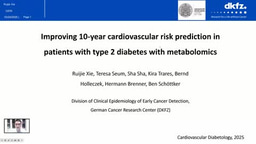Meet Cardiovascular Diabetology's Associate Editor of the Year - Dr Natalia Eberhardt
Published in General & Internal Medicine


It’s one thing to understand science in the lab but seeing how it translates into patient care has reinforced my belief that translating basic research into clinical practice is crucial for improving outcomes.
Congratulations on winning the first edition of Cardiovascular Diabetology’s Associate Editor Award! How does it feel to win the first edition?
Thank you so much! I am truly honored to receive the first edition of this award. It’s an incredible recognition, and I feel deeply grateful for the opportunity. Cardiovascular Diabetology is such a respected journal in the field, and this award not only validates the effort I’ve put into my role as Associate Editor, but also highlights the collaborative environment fostered by the editorial team and the brilliant researchers I work with. I want to especially thank Dr. Enrique Fisman, the founding editor and Editor-in-Chief, for providing me with the chance to contribute to this outstanding journal. I look forward to continuing our work together and supporting the journal’s growth.
First, please do introduce yourself!
I’m Natalia Eberhardt, a senior postdoctoral fellow at NYU Langone Health. My research began with infectious cardiovascular diseases during my PhD in Argentina, and now focuses on how conditions like diabetes, infections, and inflammation affect atherosclerosis. I study the role of immune cells in cardiovascular complications, particularly how immune responses to metabolic disorders influence atherosclerosis. I also serve as Associate Editor for Cardiovascular Diabetology, supporting the peer-review process and publishing impactful research in this critical field.
Why did you choose this research area and what would you say to grad students if they ask whether they should consider this field?
I chose to focus my research on the complex interplay between cardiovascular diseases and other diseases such as type 2 diabetes, due to the significant impact these conditions have on each other. Type 2 diabetes is a well-established risk factor for cardiovascular disease, but the underlying mechanisms connecting the two remain poorly understood. Both conditions share common pathways, including chronic inflammation, immune dysregulation, and metabolic disturbances, which exacerbate each other’s progression. I'm particularly interested in exploring the immune changes that occur in both diseases, as these alterations appear to play a crucial role in driving the onset and worsening of cardiovascular issues in diabetic patients.
To graduate students considering this field, I would say that this area of research offers tremendous opportunities to make a real difference. The intersection of cardiovascular disease, diabetes, and immune response is a rapidly growing field with a significant demand for new insights. If you’re passionate about understanding the underlying mechanisms of complex diseases and using models that closely resemble human conditions to explore these mechanisms, this is a highly rewarding and impactful area to pursue. Your work could directly contribute to better patient care and more effective treatments.
What is your vision for what you’d like to achieve with your research and work?
My ultimate vision is to contribute to a deeper understanding of the mechanisms that link diseases like diabetes, infections, and atherosclerotic cardiovascular disease, with the goal of improving clinical outcomes for patients. One of my key objectives is to help develop personalized treatment strategies that account for the unique needs of individuals with both diabetes and cardiovascular disease. By better stratifying treatments, we can offer more targeted, effective care.
How does a typical working day look like for you?
My typical day is busy but fulfilling, blending research, writing, and editorial work. I spend a lot of time analyzing data, drafting papers, and reviewing information. As Associate Editor for Cardiovascular Diabetology, I oversee manuscript submissions, collaborate with reviewers, and manage the peer-review process. I also stay engaged with the scientific community through peer reviews, meetings with collaborators, and attending conferences. It’s a lot to juggle, but I wouldn’t have it any other way!
You have been working as Associate Editor for Cardiovascular Diabetology since August 2023, what do you like about your work as Associate Editor for the journal?
What I enjoy most as Associate Editor is engaging with groundbreaking research and helping authors refine and improve their work to reach their full potential. I appreciate the diversity of topics in cardiovascular diabetology, from novel therapies to disease mechanisms. It’s rewarding to ensure important findings get the attention they deserve. What makes this experience even more enjoyable is the amazing, supportive team I work with. The collaboration has been excellent, and I’m truly grateful for the strong teamwork and the opportunity to contribute to such a dynamic, cooperative effort.
Now that you’ve worked for over a year on the journal, is the work how you expected it before, or did you have any surprises or challenges?
Overall, the work has been very much in line with my expectations, though there have been some surprises and challenges along the way. One of the most unexpected aspects has been how fast-paced the peer-review process is. The speed with which decisions are made, combined with the passion and dedication of the authors, has been both surprising and exciting. That said, balancing the responsibilities of the journal with my own research can be a bit challenging at times—especially when deadlines overlap. However, despite these challenges, the experience has been incredibly rewarding. It has not only enriched my understanding of the publication process but also helped me grow professionally.
Has the journal work had any impact on your research or views?
Absolutely. Working with the journal has greatly expanded my perspective in many ways. Reviewing a broad range of studies, including topics I hadn’t explored in depth before, has not only deepened my understanding of the field but also inspired new directions for my own research. One of the most valuable aspects has been gaining a deeper clinical insight into how essential basic science is for addressing real-world diseases. It’s one thing to understand science in the lab but seeing how it translates into patient care has reinforced my belief that translating basic research into clinical practice is crucial for improving outcomes. Overall, this experience has been incredibly enriching and has had a lasting impact on both my scientific thinking and clinical perspective.
Is there anything you would like to share with the readers of Cardiovascular Diabetology?
I’d like to take this opportunity to express my sincere gratitude to the entire Cardiovascular Diabetology team, as well as the exceptional administrative staff. It has truly been a pleasure working alongside such a dedicated and supportive group of professionals. To my fellow colleagues and researchers, I encourage you to share the word about Cardiovascular Diabetology—a fantastic platform for high-quality research that continues to make a meaningful impact in our field. I wholeheartedly recommend submitting your work to the journal and contributing to its growing body of knowledge. It’s an honor to be part of this esteemed publication, and I look forward to seeing even more groundbreaking research in the future!
If you are interested in reading more about Cardiovascular Diabetology's Associate Editor Award, visit Cardiovascular Diabetology's homepage, and if you are interested in becoming Associate Editor, please reach out me as Publisher of Cardiovascular Diabetology.
Follow the Topic
-
Cardiovascular Diabetology

This journal considers manuscripts on all aspects of the diabetes/cardiovascular interrelationship and the metabolic syndrome; this includes clinical, genetic, experimental, pharmacological, epidemiological and molecular biology research.
Related Collections
With Collections, you can get published faster and increase your visibility.
Organoids as emerging models in diabetes and cardiovascular research
Organoids—three-dimensional structures derived from stem cells—are transforming biomedical research by modeling key aspects of human physiology and disease. By replicating native tissue architecture, cellular heterogeneity, and functional behavior, they provide human-relevant systems that address limitations inherent to conventional in-vitro and animal models.
Diabetes and cardiovascular disease are deeply interconnected conditions, characterized by shared, multi-organ pathophysiology. Organoid technologies offer unique opportunities to dissect disease mechanisms, evaluate therapeutic strategies, and develop personalized, physiologically relevant models. These systems enable the investigation of cardiometabolic processes in platforms that better reflect the complexity and progression of human disease.
Cardiovascular Diabetology welcomes original research articles, reviews, and meta-analyses for this Collection, which aims to highlight the use of organoid technologies in advancing our understanding of cardiovascular complications associated with diabetes.
Areas of interest include, but are not limited to:
- Organoid models of diabetic cardiomyopathy and heart failure
- Matrigel alternatives for organoid development
- Cell-cell and extracellular matrix interactions in organoids
- Organoid-based drug testing for cardiovascular diseases
- Organoid-on-chip systems for tissue crosstalk and perfusion3D bioprinting and tissue engineering for cardiovascular organoids
- Artificial intelligence–driven analysis of organoid function and phenotypes
- Organoid models of gestational diabetes–induced congenital heart disease
- Functional genomics using CRISPR in cardiovascular organoids
- Single-cell and spatial omics to map disease states in organoids
- Co-culture systems of vascular and pancreatic organoids to study metabolic-vascular crosstalk
- Organoid-based screening platforms for anti-diabetic and cardioprotective drugs
Submissions that contribute to conceptual clarity (e.g., distinctions between organoids and spheroids), incorporate multi-organ or metabolic system perspectives, or connect technological development with clinical or translational insights are especially welcome.
This Collection supports and amplifies research related to SDG 3, Good Health and Well-Being.
All submissions in this collection undergo the journal’s standard peer review process. Similarly, all manuscripts authored by a Guest Editor(s) will be handled by the Editor-in-Chief. As an open access publication, this journal levies an article processing fee (details here). We recognize that many key stakeholders may not have access to such resources and are committed to supporting participation in this issue wherever resources are a barrier. For more information about what support may be available, please visit OA funding and support, or email OAfundingpolicy@springernature.com or the Editor-in-Chief.
Publishing Model: Open Access
Deadline: Apr 07, 2026
Cardiometabolic and Hepatic Interconnections: From Mechanisms to Clinical Implications
Cardiometabolic and liver diseases are no longer viewed as isolated entities. Growing evidence shows that hepatic and cardiovascular dysfunctions are tightly interconnected through shared metabolic, inflammatory, hemodynamic, and hormonal pathways. This crosstalk shapes disease trajectories and opens opportunities for integrated diagnostics and therapies.
Key interconnections include:
- Insulin resistance. The liver is pivotal for glucose and lipid homeostasis. Hepatic insulin resistance drives excess glucose production and dyslipidemia, contributing to the cardiovascular–kidney–metabolic (CKM) syndrome.
- Metabolic dysfunction–associated steatotic liver disease (MASLD). Highly prevalent in obesity and metabolic syndrome, and especially common in type 2 diabetes (T2D), which bears the highest MASLD burden. Progression to steatohepatitis or fibrosis markedly increases atherosclerotic risk.
- Liver-derived factors. Hepatokines (e.g., FGF21) and extracellular vesicles influence cardiac tissue, vascular tone, and systemic metabolism, potentially amplifying inflammation, oxidative stress, and lipotoxicity across organs.
- Systemic inflammation and lipotoxicity. Visceral adipose tissue and the liver release inflammatory cytokines and triglyceride-rich lipids, promoting endothelial dysfunction and perpetuating metabolic disturbances.
- Dyslipidemia. Elevated triglycerides and LDL, with reduced HDL, accelerate atherogenesis and cardiovascular risk.
- Hemodynamic and metabolic stress. Heart failure can cause hepatic congestion and hypoperfusion, while advanced liver disease can precipitate cirrhotic cardiomyopathy and arrhythmias, even in the absence of prior heart failure.
In summary, hepatic and cardiometabolic systems are functionally and pathologically intertwined: liver dysfunction worsens cardiovascular and metabolic health, and cardiometabolic disturbances accelerate hepatic pathology.
This Collection welcomes original research articles, reviews, and meta-analyses focused on this reciprocal relationship. Given the high prevalence of MASLD in T2D, we especially encourage submissions at the T2D–MASLD–cardiovascular interface. Addressing hepatic and cardiometabolic health in parallel is essential for effective risk reduction and patient care.
This Collection supports and amplifies research related to SDG 3, Good Health and Well-Being.
All submissions in this Collection undergo the journal’s standard peer review process. Similarly, all manuscripts authored by a Guest Editor(s) will be handled by the Editor-in-Chief. As an open access publication, this journal levies an article processing fee (details here). We recognize that many key stakeholders may not have access to such resources and are committed to supporting participation in this issue wherever resources are a barrier. For more information about what support may be available, please visit OA funding and support, or email OAfundingpolicy@springernature.com or the Editor-in-Chief.
Publishing Model: Open Access
Deadline: Jul 15, 2026



Please sign in or register for FREE
If you are a registered user on Research Communities by Springer Nature, please sign in